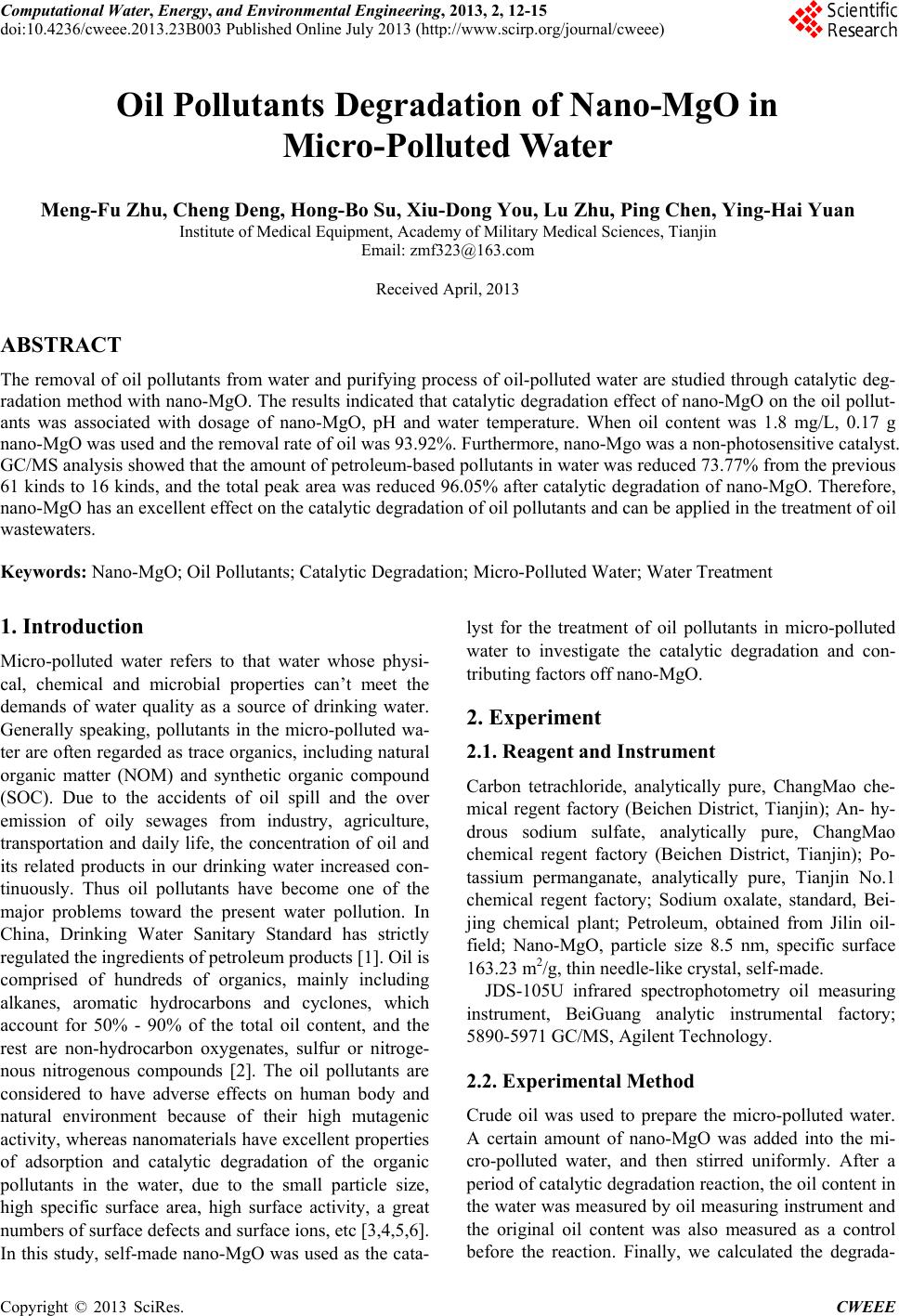
Computational Water, Energy, and Environmental Engineering, 2013, 2, 12-15
doi:10.4236/cweee.2013.23B003 Published Online July 2013 (http://www.scirp.org/journal/cweee)
Oil Pollutants Degradation of Nano-MgO in
Micr o-Polluted Water
Meng-Fu Zhu, Cheng Deng, Hong-Bo Su, Xiu-Dong You, Lu Zhu, Ping Chen, Ying-Hai Yuan
Institute of Medical Equipment, Academy of Military Medical Sciences, Tianjin
Email: zmf323@163.com
ReceivedApril, 2013
ABSTRACT
The removal of oil pollutants from water and purifying process of oil-pollu ted water are studied through catalytic deg-
radation method with nano-MgO. The results indicated that catalytic degradation effect of nano-MgO on the oil pollut-
ants was associated with dosage of nano-MgO, pH and water temperature. When oil content was 1.8 mg/L, 0.17 g
nano-MgO was used and the removal rate of oil was 93.92%. Furthermore, nano-Mgo was a non-photosensitiv e catalyst.
GC/MS analysis showed that the amount of petroleum-based pollutants in water was reduced 73.77% from the previous
61 kinds to 16 kinds, and the total peak area was reduced 96.05% after catalytic degradation of nano-MgO. Therefore,
nano-MgO has an excellent effect on the catalytic degradation of oil pollutants and can be applied in the treatment of oil
wastewaters.
Keywords: Nano-MgO; Oil Pollutants; Catalytic Degradation; Micro-Polluted Water; Water Treatment
1. Introduction
Micro-polluted water refers to that water whose physi-
cal, chemical and microbial properties can’t meet the
demands of water quality as a source of drinking water.
Generally speaking, pollutants in the micro-polluted wa-
ter are often regarded as trace organics, including natural
organic matter (NOM) and synthetic organic compound
(SOC). Due to the accidents of oil spill and the over
emission of oily sewages from industry, agriculture,
transportation and daily life, the concentration of oil and
its related products in our drinking water increased con-
tinuously. Thus oil pollutants have become one of the
major problems toward the present water pollution. In
China, Drinking Water Sanitary Standard has strictly
regulated the ingredients of petroleum products [1]. O il is
comprised of hundreds of organics, mainly including
alkanes, aromatic hydrocarbons and cyclones, which
account for 50% - 90% of the total oil content, and the
rest are non-hydrocarbon oxygenates, sulfur or nitroge-
nous nitrogenous compounds [2]. The oil pollutants are
considered to have adverse effects on human body and
natural environment because of their high mutagenic
activity, whereas nanomaterials have excellent properties
of adsorption and catalytic degradation of the organic
pollutants in the water, due to the small particle size,
high specific surface area, high surface activity, a great
numbers of surface defects and surface ions, etc [3,4,5,6].
In this study, self-made nano-MgO was used as the cata-
lyst for the treatment of oil pollutants in micro-polluted
water to investigate the catalytic degradation and con-
tributing factors off nano-MgO.
2. Experiment
2.1. Reagent and Instrument
Carbon tetrachloride, analytically pure, ChangMao che-
mical regent factory (Beichen District, Tianjin); An- hy-
drous sodium sulfate, analytically pure, ChangMao
chemical regent factory (Beichen District, Tianjin); Po-
tassium permanganate, analytically pure, Tianjin No.1
chemical regent factory; Sodium oxalate, standard, Bei-
jing chemical plant; Petroleum, obtained from Jilin oil-
field; Nano-MgO, particle size 8.5 nm, specific surface
163.23 m2/g, thin needle-like crystal, self-mad e.
JDS-105U infrared spectrophotometry oil measuring
instrument, BeiGuang analytic instrumental factory;
5890-5971 GC/MS, Agilent Technology.
2.2. Experimental Method
Crude oil was used to prepare the micro-polluted water.
A certain amount of nano-MgO was added into the mi-
cro-polluted water, and then stirred uniformly. After a
period of catalytic degradation reaction, the oil content in
the water was measured by oil measuring instrument and
the original oil content was also measured as a control
before the reaction. Finally, we calculated the degrada-
Copyright © 2013 SciRes. CWEEE